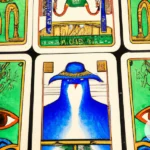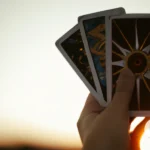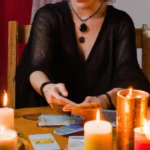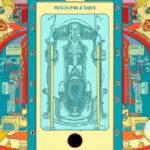Tarot cards have always been shrouded in mystery and superstition. Many people believe that these cards are a tool for predicting the future and can even bring curses upon those who misuse them. But is there any truth to these beliefs? In this article, we will explore the myth of tarot card curses and examine the origins of these superstitions. We will also discuss common misconceptions surrounding the use of tarot cards and ways to let go of harmful beliefs. Join us on this journey of breaking down the myth of tarot card curses and exploring the letting go of superstitions.
Understanding Tarot Card Curses
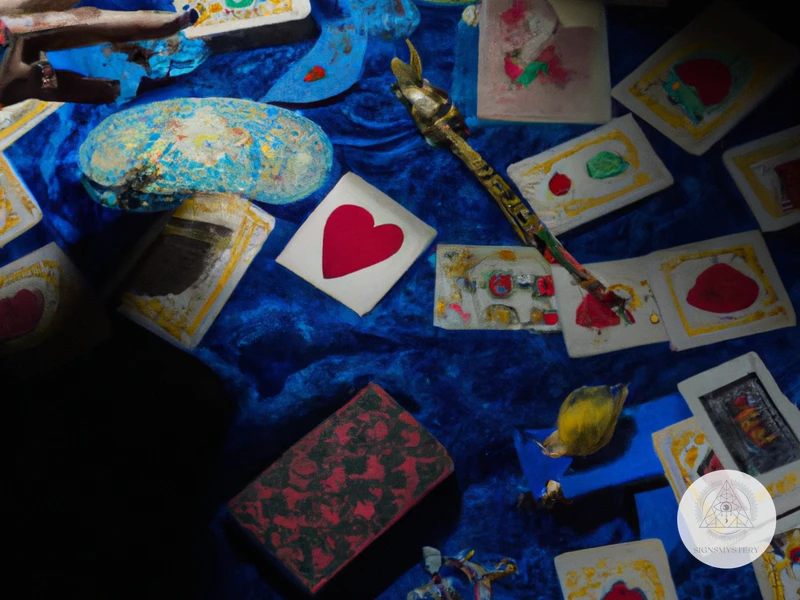
When it comes to tarot cards, many people believe in the existence of curses that can be associated with certain cards or readings. This belief has been perpetuated by pop culture and misinterpretation. However, it is important to understand what these curses truly entail and their origins. By exploring the truth and debunking the myths surrounding tarot card curses, we can gain a better understanding of tarot card readings as a whole. Let’s delve into this topic and explore the origins and misconceptions of tarot card curses without falling prey to superstitions.
What is a Tarot Card Curse?
A Tarot Card Curse is a common misconception among people new to Tarot readings. It is a belief that some cards within the deck carry an inherent negative energy that can bring about misfortunes, illness or even death, simply by handling or drawing them. This belief typically stems from a fear of the unknown and a lack of understanding about the symbolism and meaning behind the cards.
However, the truth behind Tarot Card Readings is that they are meant to guide and provide insight into different aspects of one’s life. These readings are not meant to bring harm to the individual, nor are they meant to predict their future with certainty. Instead, they help people gain a deeper understanding of themselves, their relationships or life challenges, and offer helpful advice on how to approach these topics.
The fear of a Tarot Card Curse can often lead people to be scared of Tarot readings and miss out on the potential benefits they may offer. It can also perpetuate the idea that Tarot is tied to dark magic or the occult, when in reality, it is simply a tool for introspection and self-exploration.
By exploring the realities of Tarot and Ouija Boards, we can see that they are not inherently evil or cursed, but rather tools that can be used for positive purposes. The key is to maintain a healthy perspective and not give in to the unfounded superstitions that have surrounded these divination tools for centuries.
In the following sections of this article, we will debunk some common Tarot myths and explore strategies for letting go of the fear of Tarot Card Curses.
The Origins of Tarot Card Curses
The origins of tarot card curses remain a mystery, but it is believed that they stemmed from the fears and superstitions of individuals throughout history. In the 15th century, tarot cards were used primarily for playing games, but over time, they began to be used for divination purposes where people believed that they had the power to predict the future. Many people feared the accuracy of the tarot cards and believed that they held a dark and sinister power that could curse individuals who used them.
As tarot cards became more popular, so did the superstitions surrounding them, and people began to believe that they could bring about death, bad luck, or even demonic possession. It was common for people to wrap their cards in silk to protect them from negative energy, and some even refused to touch other people’s cards for fear of the risks involved.
However, there is no evidence to support the idea that tarot cards have any kind of mystical power. They are simply a tool used for divination, and the accuracy of the readings depends on the skill of the reader and the individual’s interpretation of the cards. Despite this, the myths and superstitions surrounding tarot cards continue to persist to this day, leading many people to believe that they are cursed or that they hold some kind of dark power.
It’s important to remember that tarot cards are simply a tool for exploring the subconscious mind and gaining insight into our lives. They are not inherently dangerous or cursed, and any negative energy associated with them is purely a result of our own fears and misconceptions. By understanding the truth behind these myths and superstitions, we can begin to let go of our fears and embrace the true power of tarot card readings. If you want to know more about tarot card myths and the truth behind them, make sure to check out the article on Tarot Myths Debunked or Exploring the Realities of Tarot and Ouija Boards.
Busting Superstitions about Tarot Cards
Despite the growing interest in tarot card readings, many people still hold onto outdated superstitions about the cards themselves. It’s time to separate fact from fiction and break down these myths. Let’s explore some of the most common false beliefs about tarot cards and why they’re simply not true. By learning the truth behind these superstitions, we can develop a better understanding of how tarot cards can be used as a tool for self-discovery and personal growth. So let’s dive in and discover the truth about tarot card curses.
Major Arcana Cards are Evil
One of the most common superstitions about tarot cards is the belief that the Major Arcana cards are evil or represent bad luck. This is due in part to their often ominous or mysterious imagery, which can be unsettling for some people. However, this belief is completely false. The Major Arcana cards are simply part of the deck, and just like any other card, their meaning is open to interpretation based on the context of the reading.
It’s important to understand that tarot cards are not inherently good or bad, and that there is no such thing as a “cursed” card. Each card has its own unique meaning that can be positive, negative, or neutral depending on the individual reading. In fact, the Major Arcana cards are often seen as some of the most powerful and transformative cards in the deck, representing major life events and transitions.
By perpetuating the misconception that Major Arcana cards are evil, we limit our understanding of their potential meanings and miss out on opportunities for growth and insight. It’s important to approach each card with an open mind and a willingness to explore its true meanings.
To learn more about the truth behind tarot card readings, check out our previous article that explores common misconceptions and falsehoods. Additionally, you can read our in-depth analysis of the Death card, which is often vilified but actually has a much deeper and nuanced meaning.
Death Card Signifies Actual Death or Danger
There is a common belief among some people that the Death card in a tarot reading signifies actual death or impending danger. This misconception can lead to unnecessary fear and anxiety. However, it is important to understand that the Death card does not have a literal meaning.
Here are some reasons why the Death card does not signify actual death or danger:
- The Death card is a symbol of transformation and change, not death itself. It represents the end of one phase in life and the beginning of a new one.
- The imagery on the card, such as the skeleton and the hourglass, are symbolic of the passage of time and the inevitability of change.
- The Death card can actually be seen as a positive card, as it represents the opportunity for growth and new beginnings.
It’s important to remember that tarot cards are not fortune-telling devices and should not be used to predict exact events or outcomes. Instead, they should be viewed as tools for self-reflection and personal growth. When interpreting the Death card or any other cards in a reading, it’s important to approach them with an open mind and a willingness to explore their symbolic meanings.
You Must Wrap Your Tarot Cards in Silk
One of the most common superstitions surrounding tarot cards is the belief that you must wrap your cards in silk. This idea has been spread for generations, with many believing that silk helps to protect the energy and integrity of the cards.
However, this belief is not rooted in any factual evidence. There is no proof that silk has any special energy-conducting properties or that it is necessary for preserving the accuracy of the cards. In fact, many professional tarot readers use a variety of materials for storage and transportation, including plastic bags and wooden boxes.
It’s important to remember that at the end of the day, tarot cards are just pieces of cardboard with symbolic imagery printed on them. Their power and accuracy come from the reader’s interpretation and intuition, not from the material they are made of.
By creating a ritual of wrapping your tarot cards in silk, you may be unknowingly feeding into unnecessary superstitions and limiting your own connection with the cards. Instead of relying on external objects to validate the power of tarot, focus on developing a deeper personal connection with the cards.
Summary: Wrapping your tarot cards in silk is a common and unnecessary superstitious belief. There is no factual evidence to support the idea that silk has any unique properties that help protect the energy or accuracy of the cards. It is more important to focus on developing a personal connection with the cards through intuition and interpretation.
Using Someone Else’s Tarot Deck is Bad Luck
One common superstition about tarot cards is the belief that using someone else’s tarot deck is bad luck. The fear is that the energy and intentions of the previous user will somehow taint the deck and impact the accuracy of the readings.
However, there is no evidence to support this belief. In fact, many professional tarot readers use the same deck for years and even pass it down to their students. The energy and connection with the cards come from the reader, not the deck itself.
Additionally, some tarot decks are specifically designed to be shared and used collaboratively. For example, there are decks that feature artwork from multiple artists and have been intentionally created to be used by different people in different ways.
It’s important to remember that tarot readings are a form of spiritual and intuitive practice, and the energy and intention behind the reading is what matters most. The idea that using someone else’s deck will automatically bring bad luck is a superstitious belief that isn’t based in reality.
In fact, using someone else’s deck can actually be a positive and powerful experience. It can help you connect with the energy of the previous user and gain new insights and perspectives on the cards. By letting go of this superstitious belief, you can open yourself up to new possibilities and experiences in your tarot practice.
Superstition | Truth
— | —
Using someone else’s tarot deck is bad luck | Many professional tarot readers use the same deck for years and even pass it down to their students. The energy and connection with the cards come from the reader, not the deck itself. Additionally, some tarot decks are specifically designed to be shared and used collaboratively.
The Color of the Deck Matters
One common superstition about tarot cards is that the color of the deck matters. Some believe that certain colors hold specific energies or meanings and can affect the outcome of a reading. However, there is no factual evidence to support this claim.
Color is often used symbolically in tarot decks, but its meaning is determined by the individual deck creator and does not have any inherent power. While some decks may feature predominantly black or white colors, others may be more vibrant with a mixture of colors.
It is important to note that tarot readings are largely based on intuition and personal interpretation. The color of the deck is ultimately up to the reader’s preference and should not be a source of concern.
In fact, many tarot readers use decks with colorful and intricate designs because they find it easier to connect with the cards and gain insight from them. Ultimately, it is the reader’s understanding and connection to the deck that influences the accuracy and effectiveness of the reading.
The color of a tarot deck does not hold any intrinsic power and should not be a source of concern for those seeking a reading. The reader’s personal connection to the deck and intuitive interpretation are the main factors that affect the outcome of a tarot reading.
| Myth: | Reality: |
|---|---|
| The color of the tarot deck can impact the reading. | There is no factual evidence to support this claim. The color of the deck is ultimately up to the reader’s preference and should not be a source of concern. |
| Certain colors hold specific energies or meanings. | Color is often used symbolically in tarot decks, but its meaning is determined by the individual deck creator and does not have any inherent power. |
| Black or white tarot decks are more accurate or powerful. | The accuracy and effectiveness of the reading are determined by the reader’s personal connection to the deck and intuitive interpretation, not the color of the deck. |
The Fear of Accidentally Pulling a Negative Card
One common superstition that many people have about tarot cards is the fear of accidentally pulling a negative card during a reading. This fear stems from the belief that certain cards, such as the Death or Devil card, carry inherent bad luck and can bring about negative consequences in the future.
This belief, however, is largely unfounded. Tarot cards are simply a tool for self-reflection and introspection, and the meanings behind the cards are not set in stone. In fact, each card can have a variety of interpretations depending on the context in which it is drawn.
It is important to remember that tarot readings are not necessarily predictive in nature. Rather, they offer insight into the current situation and can help guide decisions and actions going forward.
If you do happen to draw a card that you perceive as negative, it is important to remain calm and avoid letting fear or anxiety take over.
Subscribe to Our Newsletter
Sign up to receive the latest news and updates.
Additionally, try to avoid fixating solely on negative cards during a reading. Focus instead on the overall message that the cards are conveying and consider how they can be used to improve your life in a positive way.
Some ways to overcome the fear of pulling a negative card during a reading include:
- Learning to reframe negative experiences as opportunities for growth and insight
- Trusting in the guidance of the tarot and viewing each card as an invitation to explore deeper levels of understanding
- Acknowledging and releasing any negative thought patterns or limiting beliefs that may be influencing your interpretation of the cards
- Keeping an open mind and embracing the uncertainty and mystery that comes with tarot readings
Remember, the tarot is a tool for self-discovery and growth, not a source of fear or superstition. By letting go of the fear of pulling a negative card and embracing the wisdom and insights that the tarot has to offer, you can unlock a whole new level of self-awareness and understanding.
Letting Go of Tarot Card Curses
As with any form of divination, tarot cards have been associated with numerous superstitions and myths throughout history. While some of these beliefs have been passed down through generations, others seem to be based on fear and misunderstanding. However, it’s important to challenge these beliefs and let go of any perceived curses or negative energies associated with tarot cards. In this section, we will explore the mindset and habits needed to move past these limiting beliefs so that you can unlock the full potential of the tarot cards.
Changing Your Mindset
Changing your mindset is an essential step in letting go of tarot card curses. It involves shifting your perspective from one of fear and superstition to one of empowerment and clarity. This can be a challenging shift to make, but it is necessary for fully embracing the benefits of tarot readings.
One way to change your mindset is to challenge your beliefs about tarot cards. Instead of viewing them as tools for predicting the future, try to see them as a means of gaining insight and guidance. Recognize that the cards themselves have no inherent power and that any negative interpretations are simply a reflection of your own fears and anxieties.
Another way to change your mindset is to practice mindfulness. Engage in deep breathing exercises or meditation to quiet your mind and release any negative energy or stress. This will help you approach your tarot readings with a clear and open mind, free from any preconceived notions or biases.
It is also important to take responsibility for your own decisions and actions. A tarot reading can provide guidance and insight, but ultimately it is up to you to use that information to make positive changes in your life. Acknowledge that you have the power to create your own reality and that the tarot cards are simply a tool to help you on that journey.
Lastly, be patient and kind with yourself as you work to change your mindset. Break old patterns and replace them with healthier ones.
Here are some examples of unhealthy patterns and their healthier alternatives:
Unhealthy Pattern | Healthier Alternative
— | —
Believing that the tarot cards have the power to curse you | Recognizing that the cards are just a tool for guidance
Feeling anxious or overwhelmed before a tarot reading | Practicing deep breathing or meditation to calm your mind
Blaming the tarot cards for negative outcomes in your life | Taking responsibility for your own actions and decisions
Expecting a tarot reading to predict the future with absolute certainty | Understanding that the future is always in flux and subject to change
By changing your mindset and breaking harmful habits, you can embrace the true potential of tarot readings and live a more fulfilling life.
Breaking Harmful Habits
One of the key steps in letting go of tarot card curses is breaking harmful habits. It’s important to recognize patterns of behavior that may be contributing to your superstitious beliefs and actively work to change them. This can be a challenging process, but it’s necessary in order to fully release the grip that curses and other superstitions may hold over you.
One way to identify harmful habits is to take a step back and objectively observe your behavior when it comes to tarot cards. Do you find that you’re constantly seeking reassurance or confirmation from the cards? Do you avoid certain cards or interpretations out of fear? These are signs that you may have developed an unhealthy relationship with the tarot.
Once you’ve identified harmful habits, it’s important to take action to change them. This can involve breaking some of the rules or guidelines that you may have been following in relation to tarot cards. For example, if you always felt like you needed to perform a ritual before using your tarot cards, try using them without the ritual and see if it makes a difference.
Breaking harmful habits also means being willing to let go of beliefs that no longer serve you. This can be difficult, especially if you’ve held onto these beliefs for a long time. However, it’s important to remember that letting go of harmful beliefs doesn’t mean you’re disrespecting the tarot or its history. Rather, it’s about recognizing that some beliefs may be holding you back from fully experiencing the benefits of the tarot.
In breaking harmful habits, it’s important to be patient and gentle with yourself. Remember that change takes time and effort, and it’s okay to make mistakes along the way. By actively working to change your behavior and mindset, you can free yourself from the grip of tarot card curses and embrace a more positive and empowering relationship with the tarot.
| Steps for Breaking Harmful Habits |
|---|
| 1. Identify harmful patterns and behaviors related to tarot cards |
| 2. Take action to change these patterns, such as breaking rules or rituals |
| 3. Let go of beliefs that no longer serve you |
| 4. Be patient and gentle with yourself throughout the process |
Focusing on the Positive
Focusing on the positive can help alleviate the fear and superstition surrounding tarot cards. Instead of dwelling on negative outcomes, it’s important to shift your mindset to a more optimistic outlook. This can be achieved by incorporating positive affirmations and mantras into your tarot card practice.
One way to do this is by setting an intention for your tarot card readings. An intention is a positive statement that focuses on what you want to achieve or gain from the reading. This can help you stay focused on your goals and eliminate any fear or negative thoughts.
Another way to focus on the positive is by practicing gratitude. Take a moment before your reading to reflect on the things in your life that you are grateful for. This can help put you in a positive mindset and connect with the energies of the cards in a more positive way.
Finally, it’s important to remember that tarot cards are simply a tool for self-reflection and growth. They do not hold any inherent power or ability to curse you. By focusing on the positive and approaching your tarot card practice with an open mind and heart, you can embrace the transformative power of the cards and let go of any fears or superstitions surrounding them.
| Focusing on the Positive |
|————————–|
| – Set a positive intention for your reading |
| – Practice gratitude before your reading |
| – Remember that tarot cards are simply a tool for self-reflection and growth |
| – Approach your tarot card practice with an open mind and heart |
Conclusion
As we have explored the world of tarot card curses, it is important to note that these curses are nothing more than superstitions that have been passed down through generations. While some people might still hold onto these beliefs, it is important to break free from the fear and anxiety that they can cause.
Letting go of these superstitions can be a liberating experience. It allows you to approach tarot card readings with an open mind, free from the negative energy that can come from believing in curses. By breaking harmful habits such as wrapping your deck in silk or refusing to use a deck that has been touched by someone else, you can also break the cycle of fear that can prevent you from truly embracing the beauty of tarot cards.
When it comes to reading tarot cards, it is important to focus on the positive possibilities that lie ahead, rather than the negative outcomes that some cards might suggest. By changing your mindset and focusing on the potential for growth and positivity that tarot cards represent, you can open yourself up to new experiences and bring more joy into your life.
In conclusion, tarot card curses are nothing more than outdated superstitions that have no basis in reality. By breaking free from these beliefs, we can embrace the true potential of tarot card readings and the positive impact they can have on our lives. Remember to approach tarot card readings with an open mind, break harmful habits, and focus on the power of positivity.
Frequently Asked Questions
What is the history of Tarot cards?
Tarot cards originated in Italy during the 14th century, and were originally used for playing games before evolving into a tool for divination in the 18th century.
What is the difference between the Major and Minor Arcana?
The Major Arcana consists of 22 cards that represent major life events and archetypal energies, while the Minor Arcana consists of 56 cards that represent day-to-day experiences and situations.
Do Tarot card readings predict the future?
Tarot card readings can offer insight into a situation or provide guidance, but they do not predict the future with certainty.
What is a Tarot card curse?
A Tarot card curse is a superstition that suggests getting a negative card in a reading can bring bad luck or harm to the individual.
Can Tarot cards be used for evil purposes?
Tarot cards themselves are not inherently evil or dangerous. It is the intention and actions of the person using them that determines their purpose.
Can using someone else’s Tarot deck affect my reading?
Using someone else’s Tarot deck may affect the energy of the reading, but it is not necessarily bad luck or dangerous.
What should I do if I draw a negative Tarot card?
Instead of fearing the negative card, approach it with an open mind and consider the ways it may offer insight or guidance for growth and change.
Do I need to be psychic to read Tarot cards?
No, psychic abilities are not necessary to read Tarot cards. Anyone can learn to read them with practice and study.
Can Tarot cards provide insight into relationships?
Yes, Tarot card readings can offer insight into relationships and provide guidance on how to navigate them effectively.
What are some practical uses for Tarot cards?
Tarot cards can be used for personal growth and self-reflection, making decisions, gaining clarity on situations, and creative inspiration, among other practical uses.







